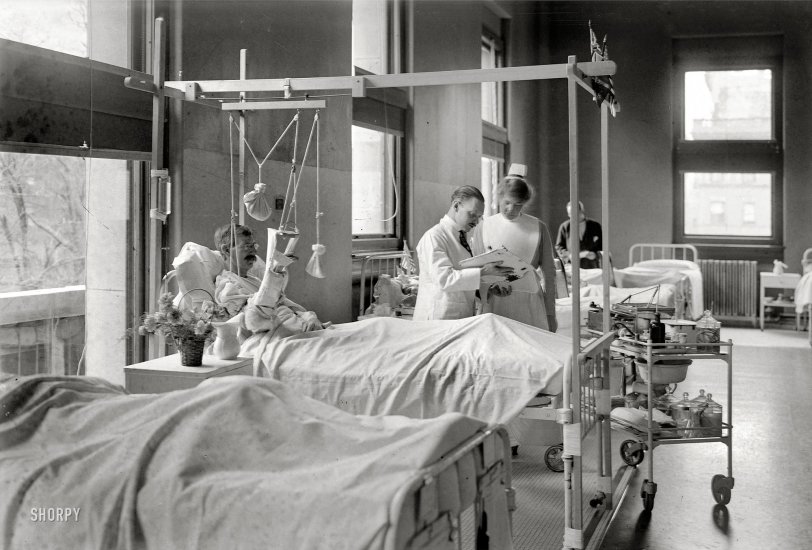


Framed or unframed, desk size to sofa size, printed by us in Arizona and Alabama since 2007. Explore now.
Shorpy is funded by you. Patreon contributors get an ad-free experience.
Learn more.

- Indiana Harbor Belt abides
- Freezing haze
- Corrections (for those who care)
- C&NW at Nelson
- Fallen Flags
- A dangerous job made worse
- Water Stop
- Passenger trains have right of way over freights?
- Coal
- Never ceases to amaze me.
- Still chuggin' (in model form)
- Great shot
- Westerly Breeze
- For the men, a trapeze
- Tickled
- Sense of loneliness ...
- 2 cents
- Charm City
- What an Outrage
- Brighton Park
- Catenary Supports
- Just a Little Before I was Born
- Afternoon normal
- The Flat Iron Cafe survives
- Aging in Place
- Raise your hand
- Good and Bad
- Oh, the 70's
- Nooooooi
- The aluminum tubing
Print Emporium
On the Mend: 1917

New York, May 1917. "St. Luke's Hospital men's ward." One of the Actors Fair partygoers, perhaps. Bain News Service glass negative. View full size.
Too Early For War Wounds
Or at least for battlefield injuries. The US entered World War I in early April 1917, and the first small contingents of American troops didn't arrive in France much before June 1917. The other option for American Army patients is training accidents.
Naval operations aren't that promising for injuries either. The German navy didn't operate in US waters until April 1918, and while American destroyers did operate in the Atlantic against U-Boats they were based out of Queenstown (now Cobh) in Ireland where the Royual Navy had its own base facilities.
So my best guess is that if these people really are in the military their injuries are most likely from training.
Re: War Victims
An Alcohol soaked Catheter, just kill me now please!
War victims
From the flags these men may be under care for wounds suffered in the First World War. This fellow may have a shattered elbow. The jars on the cart could be alcohol for keeping catheters clean and sterile. The metal box is most likely a instrument box that could be sterilized as a whole. By the early part of the 20th century medicine was becoming aware of germs and sanitary proceedures, in part to Dr Lister.
He still has one good hand
so he can work the Remote.
Contents of cart
I can't recognize much of what is on that cart, but I'd sure like to know! I'm sure someone here has an idea about some of it.
More:
Sterile procedures were finally becoming routine by this time, but were recognized much earlier. Dr. Ignaz Semmelweiss, 1818-1865, had understood how infection was spread and was advising physicians to wash their instruments and hands between patients. He had to deal with resistance and even ridicule. His methods, when followed, were effective at sharply decreasing mortality in new mothers, from infection, by the middle of the 19th century. However, puerperal fever was a common cause of death in women until well into the 20th century. Pasteur built on Semmelweiss's work and Lister took it further. It is an interesting commentary on the medical profession that there was so much resistance to it for so long.
Leave Me Not
May 1917 doesn't seem accurate. Not a leaf to be seen on the trees out the window. March or April, maybe.
























On Shorpy:
Today’s Top 5